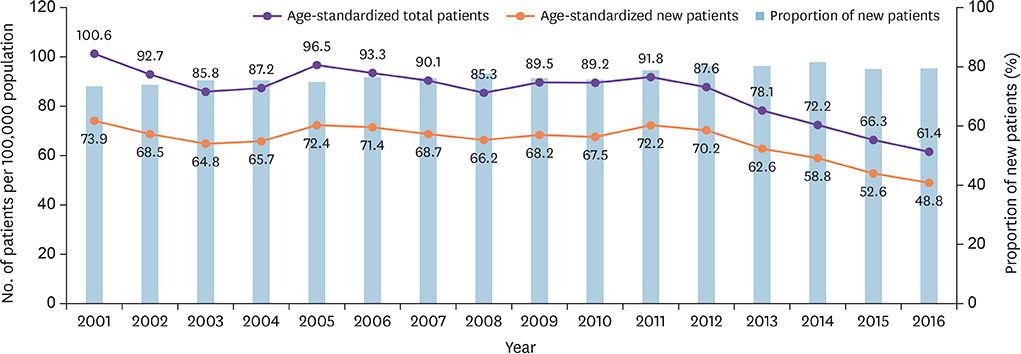Infect Chemother.
2019 Dec;51(4):414-426. 10.3947/ic.2019.51.4.414.
Modern History of Tuberculosis in Korea
- Affiliations
-
- 1Asia Pacific Foundation for Infectious Diseases (APFID), Seoul, Korea. ansorp@gmail.com
- 2Division of Infectious Diseases, Samsung Medical Center, Sungkyunkwan University School of Medicine, Seoul, Korea.
- KMID: 2466475
- DOI: http://doi.org/10.3947/ic.2019.51.4.414
Abstract
- Tuberculosis has been a major public health threat in modern Korea. A few reports from the mid-1940s have demonstrated a high prevalence of latent and active tuberculosis infections. The high disease burden urged the newly established government to place a high priority on tuberculosis control. The government led a nationwide effort to control tuberculosis by building dedicated hospitals, conducting mass screening, providing technical and material support for microbiological diagnosis, administering Bacillus Calmette-Guérin vaccination, and improving appropriate antibiotic treatment through public health centers. Such concerted efforts resulted in a gradual decrease in the disease burden of tuberculosis, as demonstrated by National Tuberculosis Prevalence Surveys and notifiable disease statistics. While great progress has been made, new challenges - including an aging population, outbreaks in schools and healthcare facilities, and migration from high-prevalence countries - lie ahead. Here, we review the modern history of tuberculosis in Korea, focusing on epidemiology and public health policies.
Keyword
MeSH Terms
Figure
Cited by 1 articles
-
Latent Tuberculosis Infection Screening and Treatment in Congregate Settings (TB FREE COREA): Demographic Profiles of Interferon-Gamma Release Assay Cohort
Hyung Woo Kim, Jinsoo Min, Joon Young Choi, Ah Young Shin, Jun-Pyo Myong, Yunhee Lee, Hyeon Woo Yim, Hyunsuk Jeong, Sanghyuk Bae, Eunhye Shim, Hyekyung In, Chaemin Chun, Gahee Kim, Ji Young Kang, Sung-Soon Lee, Jae Seuk Park, Ju Sang Kim
J Korean Med Sci. 2021;36(36):e246. doi: 10.3346/jkms.2021.36.e246.
Reference
-
1. A four hundred million-won project for welfare and health: orphanages and nursing homes will be built; National Tuberculosis Hospitals in Suwon and Masan [Korean]. The Dong-A Ilbo. 1946. 04. 22.2. Four hundred thousand people infected with tuberculosis in South Korea [Korean]. The Dong-A Ilbo. 1948. 06. 15.3. Future of the country at risk: crisis in childhood health [Korean]. The Dong-A Ilbo. 1948. 09. 30.4. Red light on national health! Two million people infected with tuberculosis [Korean]. The Dong-A Ilbo. 1949. 05. 22.5. Three hundred fifty thousand patients with a nation-ruining disease [Korean]. The Dong-A Ilbo. 1949. 02. 16.6. Response urgently needed against tuberculosis, an enemy of national health [Korean]. The Dong-A Ilbo. 1951. 02. 15.7. Average daily death of three hundred patients [Korean]. The Dong-A Ilbo. 1954. 09. 29.8. Korean National Tuberculosis Association (KNTA). History of Tuberculosis in Korea. Seoul: KNTA;1998.9. Hong YP. Tuberculosis in Korea - yesterday, today, and tomorrow. Tuberc Respir Dis. 1997; 44:1–10.
Article10. Ministry of Health and Social Affairs, Korean National Tuberculosis Association. National Tuberculosis Prevalence Survey results. 1965.11. Kim SJ, Hong YP, Lew WJ, Yang SC, Lee EG. Incidence of pulmonary tuberculosis in Korean civil servants. Tuber Lung Dis. 1995; 76:534–539.
Article12. Bai GH, Kim SJ, Lee EK, Lew WJ. Incidence of pulmonary tuberculosis in Korean civil servants: second study, 1992-1994. Int J Tuberc Lung Dis. 2001; 5:346–353.13. World Health Organization (WHO). Global tuberculosis report 2016. Geneva, Switzerland: WHO;2016.14. Korean National Tuberculosis Association. 7th Korea National Health and Nutrition Examination Survey, 1st year (2016) Tuberculin survey support and quality control. Seoul: Korea Centers for Disease Control and Prevention;2017.15. Korean Statistical Information Service. National Health Insurance Statistical Yearbook. 2016. Accessed 30 October 2019. Available at: http://kosis.kr/statisticsList/statisticsList_01List.jsp?vwcd=MT_ZTITLE&parentId=D#SubCont.16. Han YC. Short-course therapy of tuberculosis. J Korean Med Assoc. 1985; 28:345–354.17. Economic Planning Board. Annual report on the cause of death statistics. Seoul: Statistics Korea;1991.18. Korea Centers for Disease Control and Prevention (KCDC). 2016 annual report on notified tuberculosis in Korea. Osong: KCDC;2016.19. Korean National Tuberculosis Association (KNTA). 60-year History of Korean National Tuberculosis Association. Seoul: KNTA;2014.20. The Masan Tuberculosis Sanitorium [Korean]. The Dong-A Ilbo. 1946. 05. 04.21. Five percent of factory workers diagnosed with tuberculosis: treatment given after mass screening [Korean]. The Dong-A Ilbo. 1948. 04. 22.22. Four hundred thousand patients with lung disease in South Korea [Korean]. The Dong-A Ilbo. 1949. 04. 02.23. Lee YK, Kwon YH, Lee SC, Son HJ, Go UY. Overview of tuberculosis control and prevention polices in Korea. Public Health Weekly Report. 2015; 8:651–656.24. Hong YP. Epidemiology of tuberculosis: On the basis of nation-wide tuberculosis prevalence surveys. J Korean Med Assoc. 1991; 34:468–476.25. Hong YP, Kim SJ, Lew WJ, Lee SH, Lee EK. Cohort analyses of the treatment of smear-positive pulmonary tuberculosis patients under programme conditions in Korea, 1983-1994. Int J Tuberc Lung Dis. 1998; 2:365–371.26. Kim HJ. Current situation of tuberculosis and its control in Korea. J Korean Med Assoc. 2006; 49:762–772.
Article
- Full Text Links
- Actions
-
Cited
- CITED
-
- Close
- Share
- Similar articles
-
- Oriental medicine as a heterogeneous ensemble
- Cultural Morphology of Eating Disorders
- Statistics and Colonial Medicine: A Doubt and Controversy on Tuberculosis Statistics in Colonial Korea
- Introduction of the modern western medicine in late Choson period (I)
- Christian Ideals in the History of Medical Care



